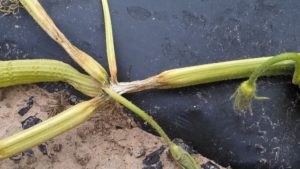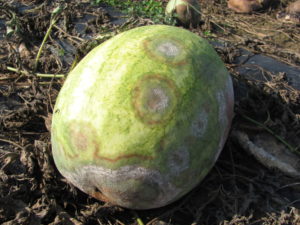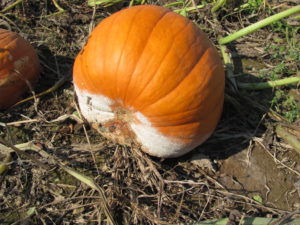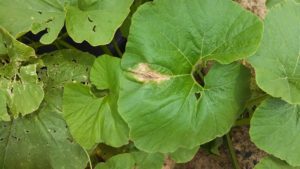This disease was a serious problem in much of the state this past summer. As a result, I have had many questions about managing this disease. The questions I have been asked have ranged from what do I spray to how does this disease work? Therefore, I have written an article about the symptoms, biology and management of Phytophthora blight. I will concentrate on Phytophthora blight of cucurbits, but this disease is also a very serious problem on peppers. In the following article, I will outline some of the information I think it is important to know about this important disease.
Phytophthora blight-biology
Phytophthora blight is caused by a fungus-like organism known as Phytophthora capsici. Even when I was in graduate school in the 1980’s, my professors told us that we would discuss Phytophthora and related organisms in our fungus taxonomy class even though these organisms are more closely related to brown algae than to fungi. This is why we refer to the organisms that cause Phytophthora blight and downy mildew as fungus-like organisms.
I promise not to bore you with a detailed taxonomy of these organisms. But the taxonomy of Phytophthora capsici is important.
- We will discuss how Phytophthora blight is favored by heavy rains, standing water and poorly drained fields. This makes sense when one remembers that this fungus-like organism is closely related to the brown algae, an organism that lives in water. Sometimes you will hear Phytophthora and related organisms called ‘water molds’.
- The fungicides that are most effective against Phytophthora blight and downy mildew are often not the same products that are effective against, for example, anthracnose and powdery mildew. This is because anthracnose and powdery mildew are caused by fungi; Phytophthora blight and downy mildew are not really fungi and have different biochemistries than fungi.
Phytophthora capsici has a rather large host range. In addition to causing disease on all cucurbits, Phytophthora blight can cause disease on pepper, tomato, eggplant as well as snap beans and lima beans. Pepper plants are particularly susceptible to Phytophthora capsici. While tomato plants do not usually have as severe symptoms as cucurbits or pepper, Buckeye rot of tomato fruit can be caused by Phytophthora capsici as well as by additional species of Phytophthora. Artificial inoculations in a greenhouse have resulted in Phytophthora blight symptoms on spinach, radish, turnip, onion and carrot. The common purslane, jimson weed and nightshade are among the weed hosts for Phytophthora capsici. Since many plants are susceptible to Phytophthora capsici, it is difficult to use crop rotation as an effective means of managing Phytophthora blight. I have had growers complain about a vegetable crop with Phytophthora blight in a field which hadn’t had, for example, pumpkins in many years. Part of the reason that Phytophthora blight can occur in such situations is the large host range described here. (Phytophthora root rot and stem rot of soybean is caused by Phytophthora sojae, a different organism than the one described here.)
Another reason that crop rotation is not always effective against Phytophthora blight is because of the long-lasting spores that this fungus possesses. It turns out that there are two mating types of Phytophthora capsici. If both mating types are present in a field, which is common, a spore type known as an oospore may form. Oospores may survive 10 years or more in the absence of any host. Crop rotations of at least 4 years without a susceptible host are recommended. However, oospores may survive longer than 4 years. The combination of a large host range and resilient spores means that crop rotation is not usually recommended as a stand-alone management technique.
The long-lived oospore isn’t the only spore type for Phytophthora capsici. A spore type known as sporangia may form when the temperature and moisture conditions are right. Sporangia look like balloons on stalks. In the presence of water, each sporangium may break open to release 20 to 40 zoospores. Zoospores are motile and can swim to cause another infection. Zoospores may also be splashed from leaf to leaf or from plant to plant. One of the recommendations for Phytophthora blight is to manage water: avoid poorly drained fields, use raised beds, avoid overhead irrigation. The motile zoospores and taxonomic relationship to the brown algae are some of the biological relationships that go into making those recommendations.
One more item regarding the water-loving nature of Phytophthora capsici: This fungus can survive in water. This fungus-like organism can wash off into a river or pond, surviving for period of time. If this water is then used for irrigation, the crop can be inoculated with Phytophthora capsici. Even farms downriver can end up getting Phytophthora blight from water.
Temperature and relative humidity are additional factors in understanding the biology of any plant/ pathogen system. Using cucumber fruit, 77°F was the best temperature for lesion formation. However, lesions formed on cucumber from 59°F to 86°F. Lesions formed on cucumbers from 35 to 100 percent relative humidity. Phytophthora blight may cause disease, therefore, under a great range of environmental conditions.
Phytophthora blight-symptoms
Phytophthora blight symptoms may be observed on all above–ground parts of a cucurbit plant. However, cucumbers and watermelons usually have symptoms on fruit, but not on foliage. On the other hand, lesions readily form on the leaves and stems of pumpkins and squash (Figure 1). Cantaloupe, while perhaps less sensitive to Phytophthora blight than the other hots listed here, may have symptoms on foliage or fruit.
Lesions on leaves often start out a light green, sunken area that may be wedge shaped, becoming wider toward the margin of the leaf. With time, the lesions become necrotic. Stem lesions may cause the vine to wilt from the constricted area out toward the end of the vine (Figure 2). Lesions on fruit vary depending on the host. Lesions on watermelon are often round, water-soaked and may appear as a bruise (Figure 3). Under moist conditions, these lesions are covered with a white mold, caused the growth of P. capsici. Lesions on fruit may be more common on the underside of the fruit where moisture accumulates (Figure 4). Fruit lesions on pumpkin may be large and occur in no particular shape. Phytophthora blight may also cause damping-off of seedlings.

Figure 2. This stem lesion on this pumpkin vine, caused by Phytophthora blight, will result in the death of the vine from this point to the end away from the plant.

Figure 3. The round lesions on this watermelon are caused by Phytophthora blight. Note that the Phytophtora blight fungus can be seen sporulating on the lesion under moist conditions.

Figure 4. The Phytophthora blight fungus is sporulating on the lesion on the underside of this pumpkin.
Symptoms caused by Phytophthora blight may appear similar to other diseases. For example, Pythium may also cause damping-off; often it is not possible to tell the difference between damping-off caused by Pythium and Phytophthora blight. Fusarium fruit rot of pumpkin may cause a white mold on pumpkin fruit similar to Phytophthora blight. Fusarium fruit rot lesions on pumpkin tend to appear drier compared to lesions caused by Phytophthora blight. White mold of pumpkin may be mistaken for Phytophthora blight; however, the former disease is accompanied by irregularly shaped, dark fungal bodies.
While experienced growers may learn to recognize symptoms of Phytophthora blight, if there is any doubt, it is always good to send lesions to the Purdue Plant and Pest Diagnostic Laboratory .
Phytophthora blight management
Management of Phytophthora blight with fungicides is not possible unless cultural methods are also put into place. Even the best management schemes, chemical and cultural, may fail to control Phytophthora blight completely when weather conditions are conducive to the disease. Therefore, cultural management methods will be discussed first.
Water management is perhaps the most important control measure for Phytophthora blight. If possible, choose fields with well drained soils. At best, such fields will have soils sufficiently light so that rains seep into the field shortly after each rain. If the soils are relatively heavy, hopefully there are no areas where water ponds after a rain. Even a few such areas are likely to be hot spots where Phytophthora blight can start. Once the disease has a foothold, Phytophthora blight can quickly work its way across a field, splashing from plant to plant.
Plants on raised beds are less likely to have the crown area under water after heavy rains. Thus, the use of raised beds may help plant survival. The use of drip irrigation instead of overhead irrigation, if possible, will help to reduce spread of the disease. Overhead irrigation, if used, should be applied so that the leaf surfaces dries before dew formation. Under no circumstances should irrigation water be allowed to stand in the field.
The use of a no-till situation such as for pumpkin or squash planted into a wheat cover crop may reduce splash dispersal of the P. capsici spores and generally seems to keep the surface of pumpkins clean.
It is not clear whether plastic mulch favors Phytophthora blight or not. On the one hand, plastic mulch can act as a barrier to soil which may harbor P. capsici. On the other hand, water may readily pool on the plastic; such pools may contain P. capsici which may then splash up into the canopy with the next rain. Perhaps plastic mulch that is well fitted to slightly domed beds will act as a management tool for Phytophthora blight. Beds that are domed will help prevent water from standing on plastic mulch.
Since P. capsici spores may survive in surface water, a pond used for irrigation may spread P. capsici if a vegetable field with Phytophthora blight drained into that pond. A field with Phytophthora blight that drains into a river or stream may lead to spread of the disease in a field downstream.
There are no cultivars with host resistance to Phytophthora blight in cucurbits. Through experience, however, growers may learn what varieties are very susceptible and should be avoided.
Another feature of the Phytophthora blight organism is its potential to survive a long time in the soil. Most specialists recommend at least a 4-year crop rotation before planting a cucurbit crop. In the meantime, avoid susceptible crops such as tomatoes, peppers and green beans (see biology section).
Fungicides are an important part of most management schemes for cucurbit Phytophthora blight. However, under conducive weather conditions and in the absence of the cultural controls mentioned above, fungicides will be ineffective. In addition, some strains of P. capsici have been shown to be resistant to select fungicides.
While cucumber and watermelon fruit are very susceptible to Phytophthora blight, the foliage is not usually affected. In contrast, pumpkin and squash fruit and foliage are susceptible to Phytophthora blight. Therefore, cucumber and watermelon fruit need to be protected by fungicides, while pumpkin and squash foliage and fruit need to be protected. Cantaloupe foliage and fruit may be symptomatic, but this crop doesn’t seem as susceptible as the other crops mentioned here.
Fungicides should be applied to pickling cucumber when fruit are 1, 2 and 3 inches long in addition to applications before and after significant rain events. Watermelon should have a preventative fungicide application at softball stage and approximately weekly thereafter.
Effective fungicides include:
- Zampro®
- Revus 2.08 SC®
- Elumin®-to be labeled in 2018.
- Presido 4FL®
- Ranman®
- Ridomil Gold® – Since strains of the Phytophthora blight fungus that are resistant to Ridomil might be present, be sure to alternate this product with others with different modes of action.
- Orondis® products (Orondis Ultra®, Orondis Ridomil Gold® and Orondis Opti®). These products may be available at pre-mixes or co-packs. Orondis Ridomil Gold® may be applied at planting, in furrow, through drip or in transplant water. Orondis Opti® and Orondis Ultra® may be applied as foliar sprays. Do not follow a soil application of Orondis Ridomil Gold® with foliar applications of either Orondis Ultra® or Orondis Opti®. While Orondis Ultra® and Orondis Ridomil Gold® are combinations of two different systemic active ingredients, Orondis Opti® is a combination of a systemic and a contact active ingredient.
- The use of Actigard®, Forum® and products with phosphite as an active ingredient (e.g., Agri-Phos®, Confine Extra®, Phostrol®, Rampart®) in spray programs early in the rotation can be helpful.
- The products Gavel® and Zing!® are premixes of the systemic active ingredient zoxamide and the contacts mancozeb and chlorothalonil, respectively. These products may be useful because the combination of systemic and contact active ingredients can help manage fungicide resistance.
It is essential that one use products in such a way as to alternate FRAC codes. Use several different modes of action in a year if possible. In addition, some of these products have restrictions on how many times they can be used in a season. Re-entry periods and pre-harvest intervals should be noted on the label. For the most part, these products will not be useful controlling foliar diseases such as gummy stem blight, powdery mildew or anthracnose. Some of the products listed as effective against Phytophthora blight may also be effective against downy mildew. However, downy mildew is not present every year in Indiana.
Phytophthora blight can be serious and difficult to control because it is a foliar disease caused by an organism that survives years in the soil in the absence of a host. Many foliar diseases do not survive for long periods without a host; an example would be anthracnose of watermelon which may spread rapidly across a field, but survives in crop residue-not as a resilient spore. Fusarium wilt of watermelon, in contrast, is a soil borne disease that can survive for years in the soil, but does not spread across the field in one season. Because Phytophthora blight is a foliar disease caused by an organism that survives well in the soil, management can be a challenge in years when the weather is conducive to this important disease.
